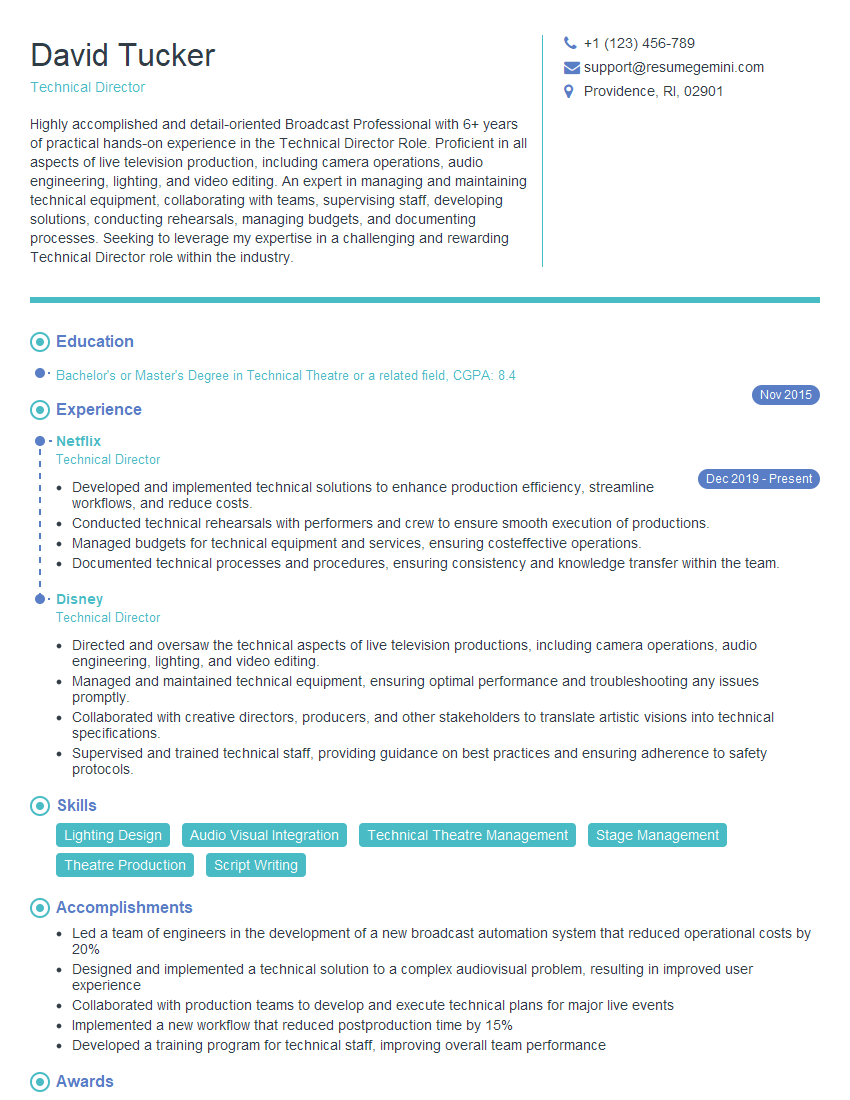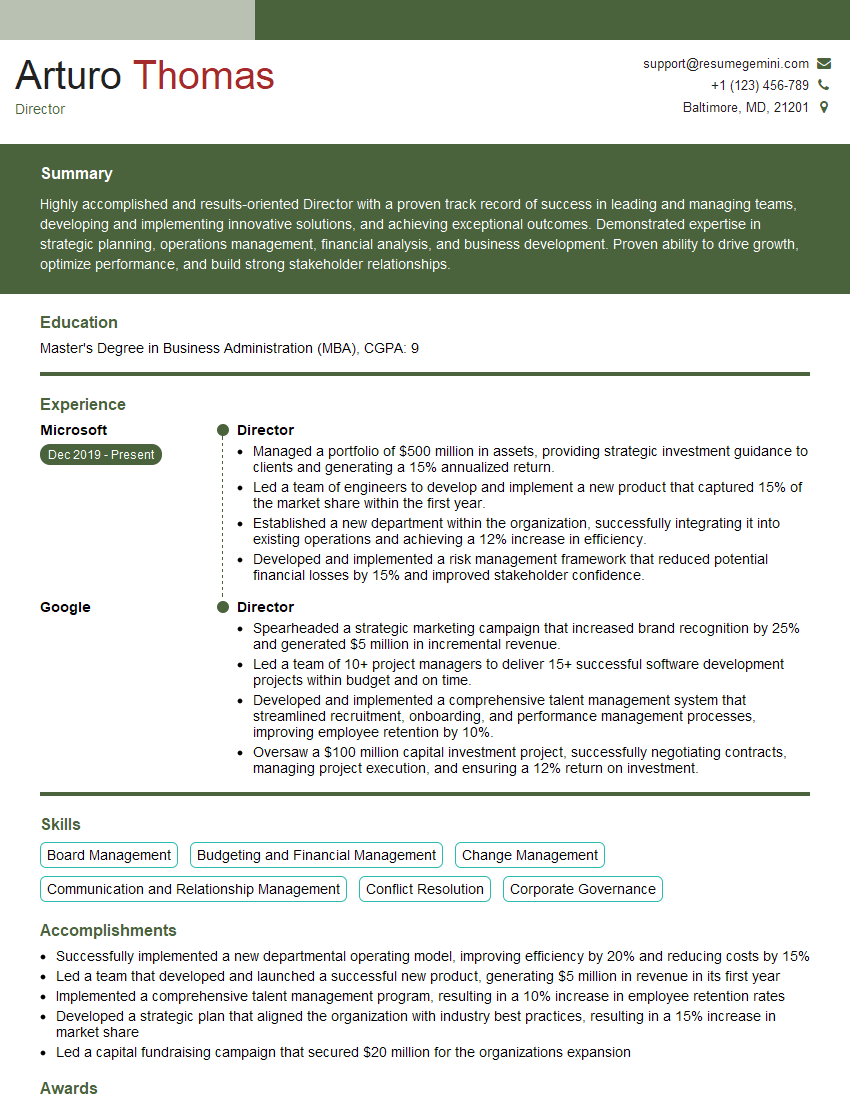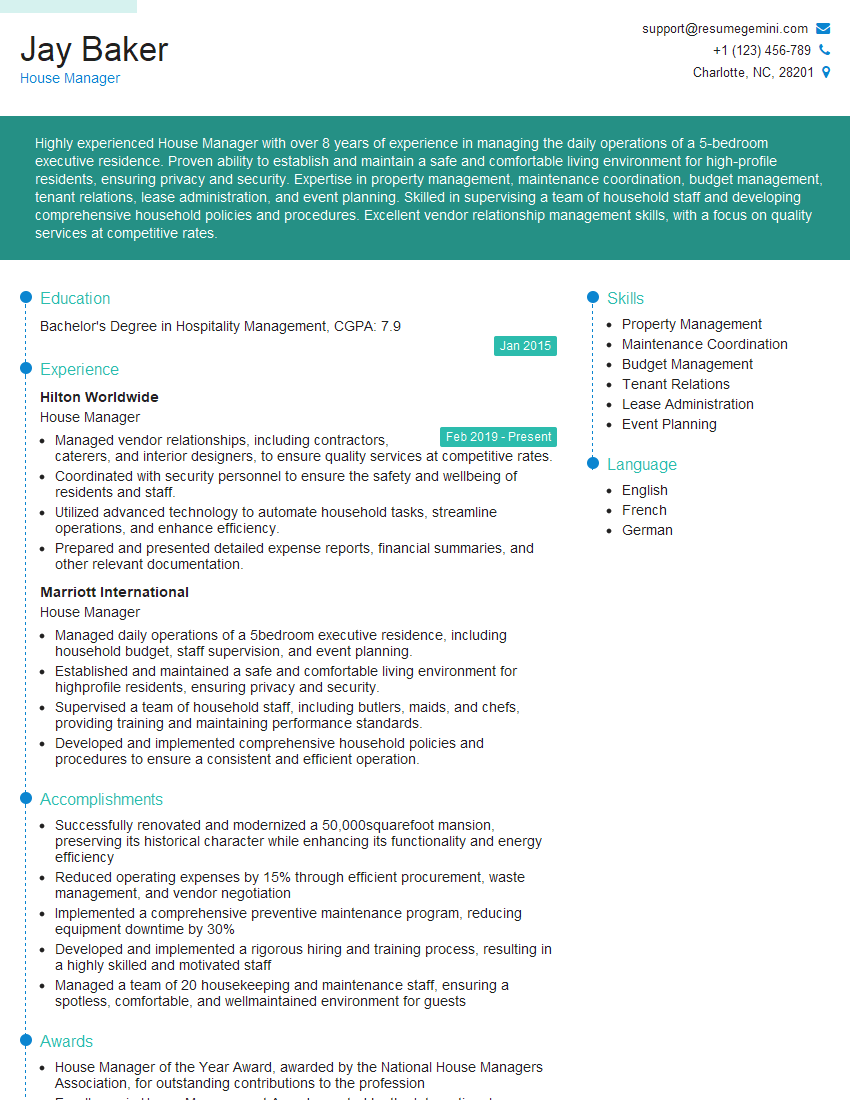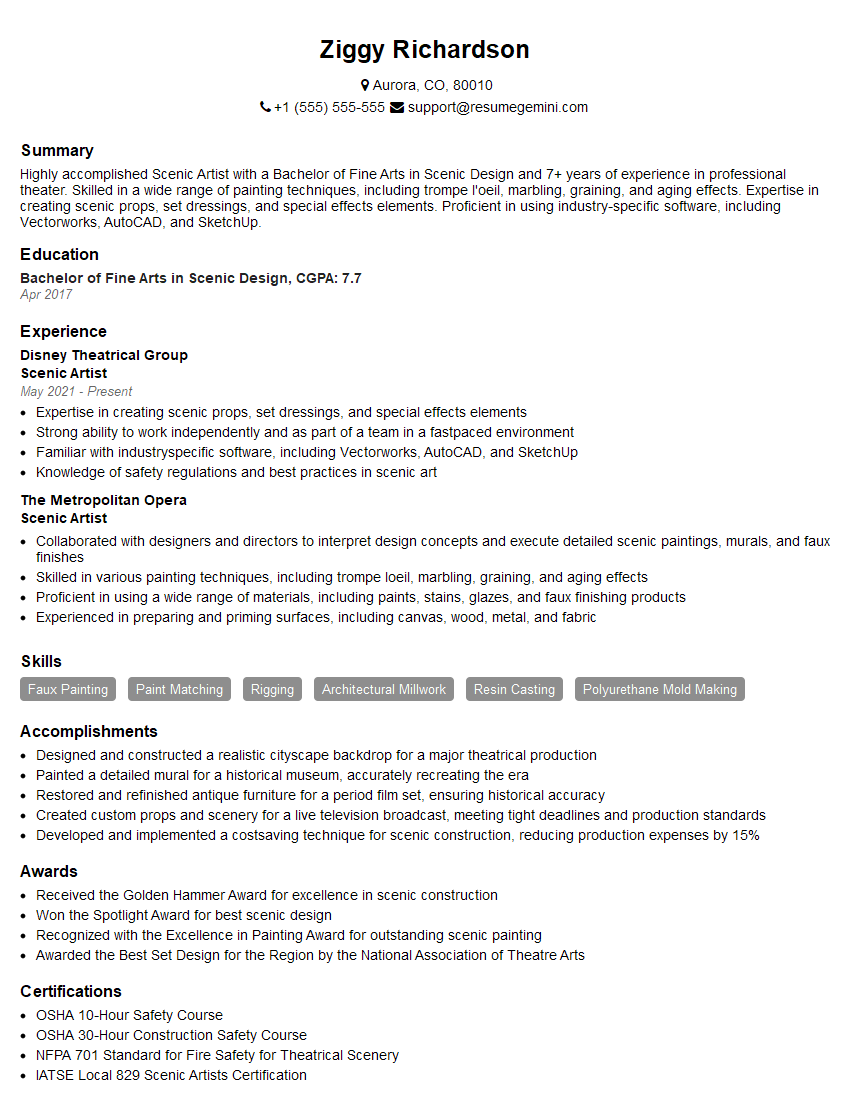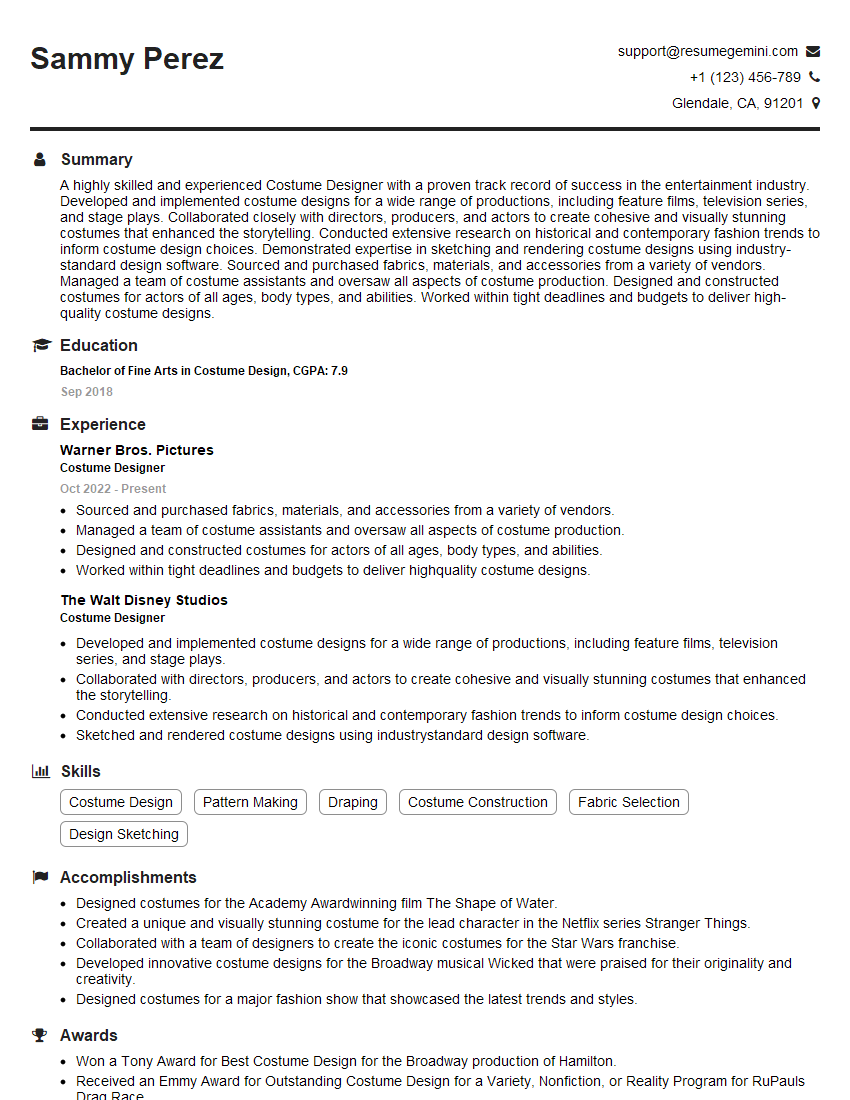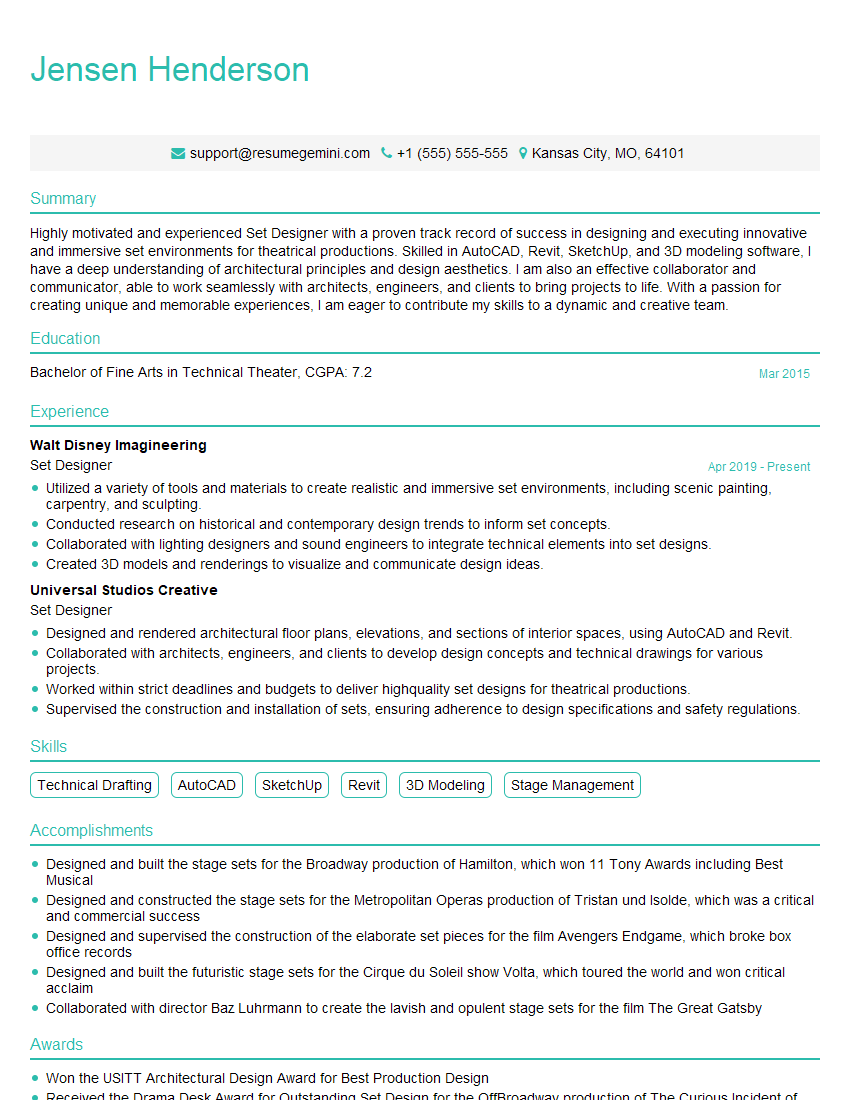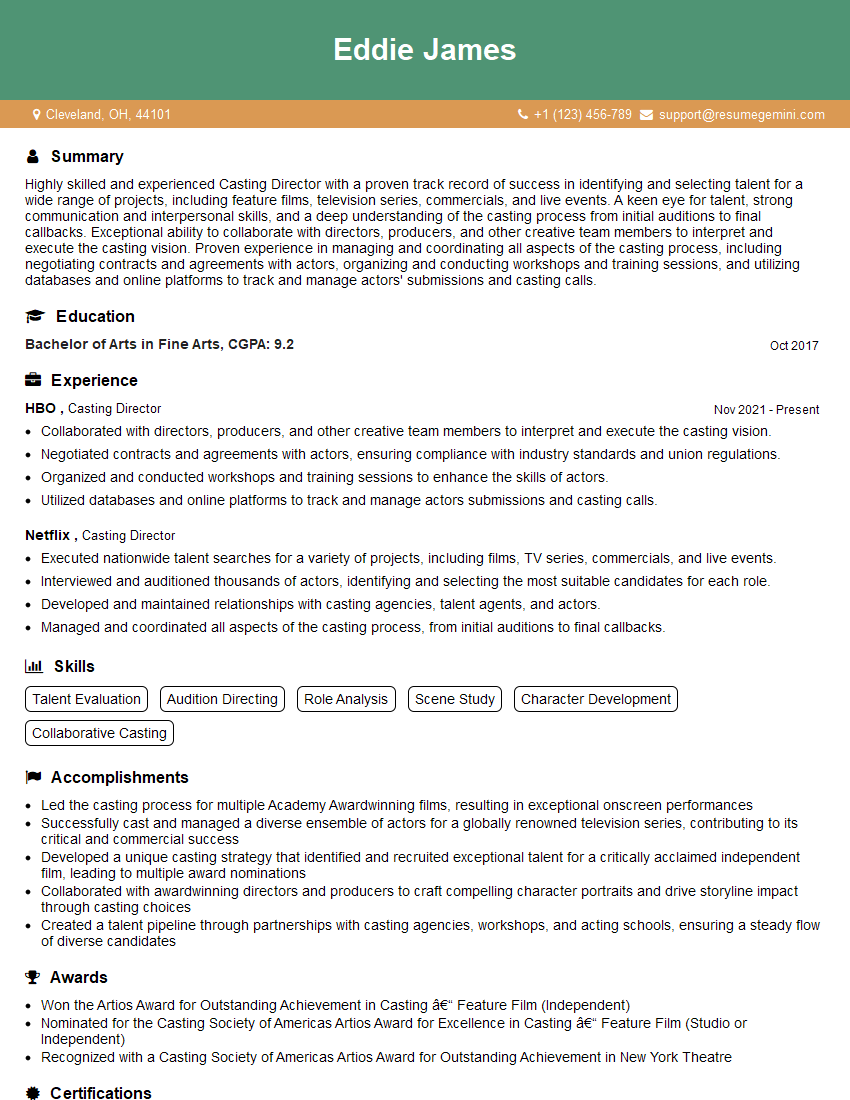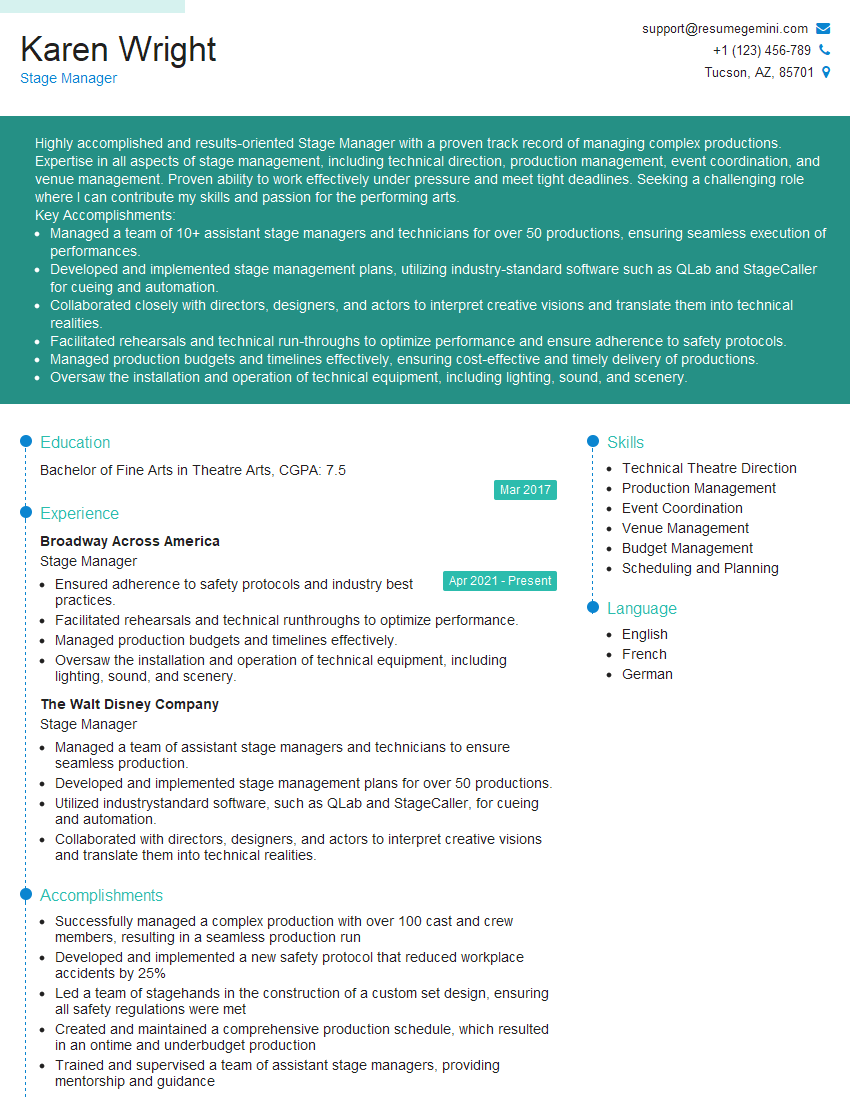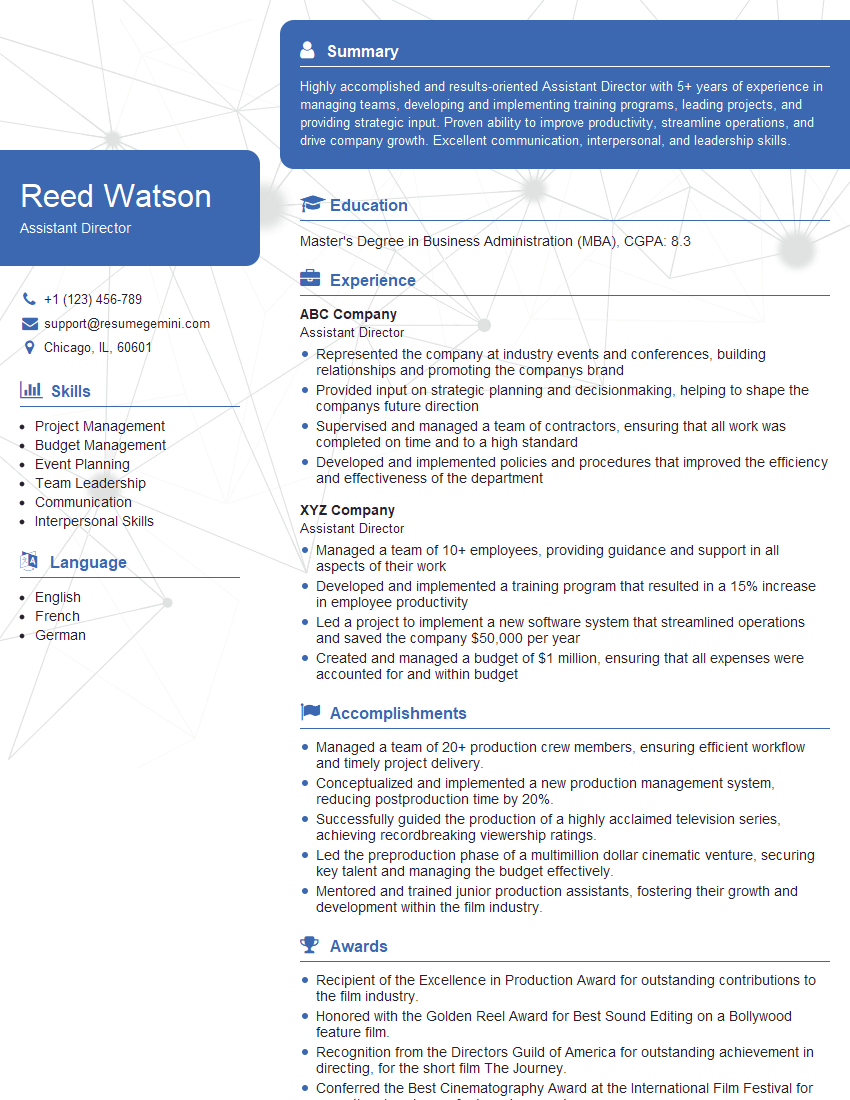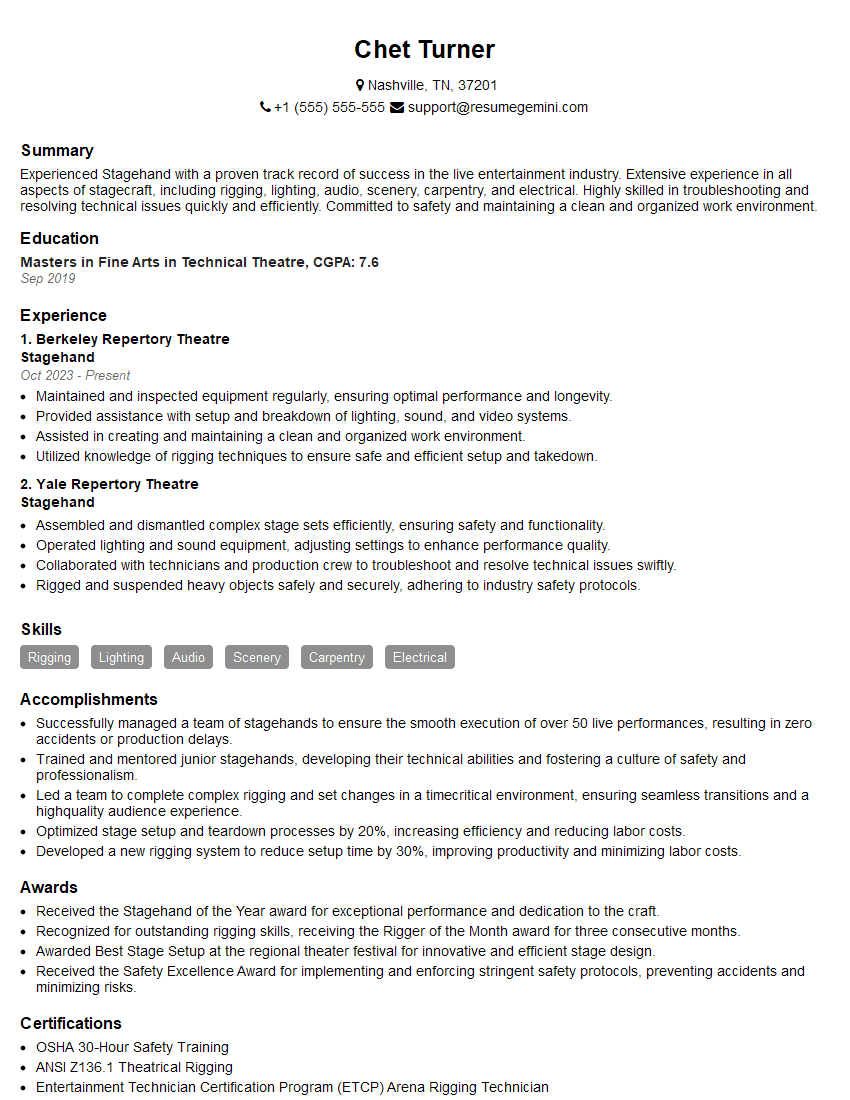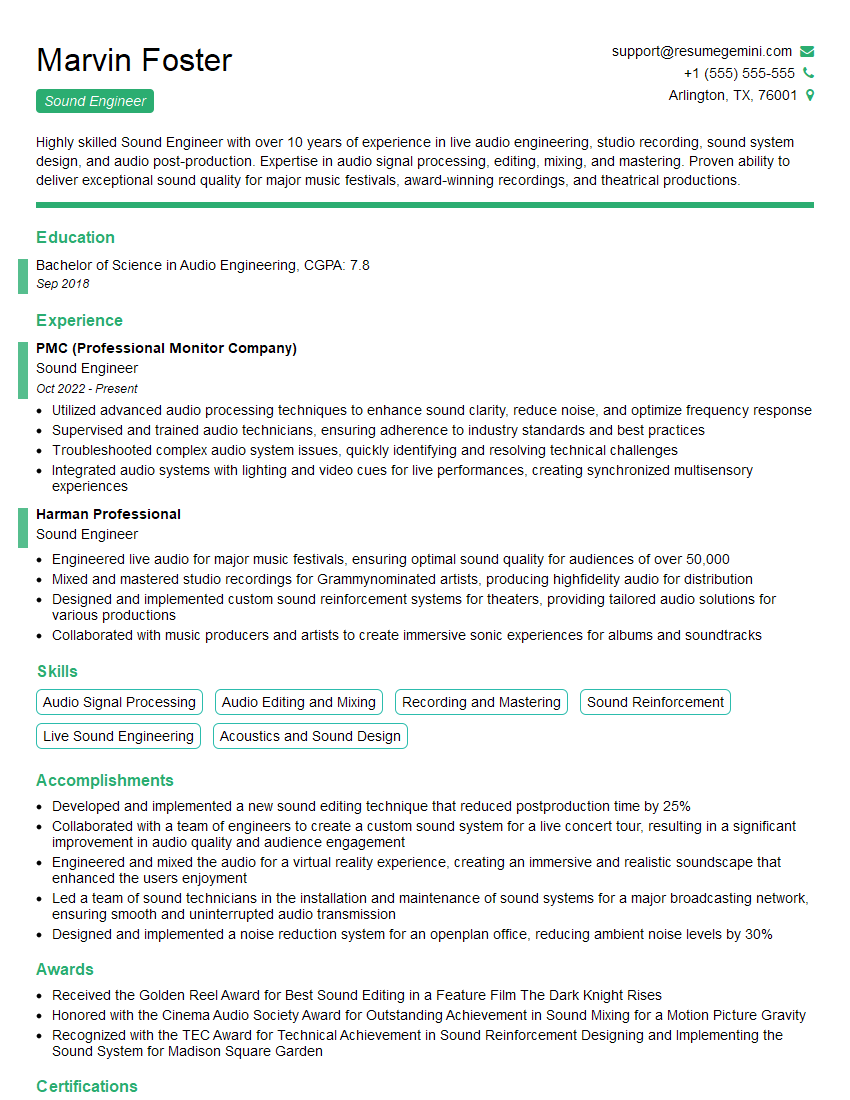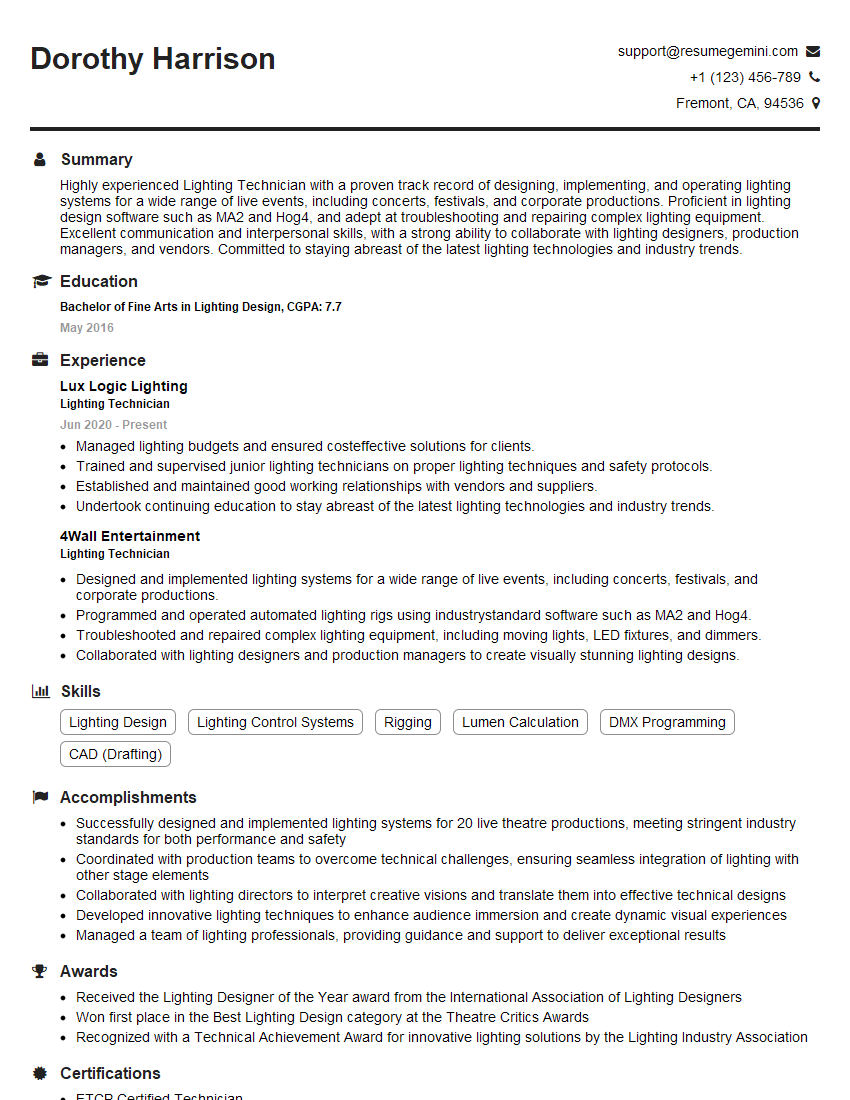Cracking a skill-specific interview, like one for Understanding of theatrical terminology and production processes, requires understanding the nuances of the role. In this blog, we present the questions you’re most likely to encounter, along with insights into how to answer them effectively. Let’s ensure you’re ready to make a strong impression.
Questions Asked in Understanding of theatrical terminology and production processes Interview
Q 1. Define ‘strike’ in a theatrical context.
In theatre, ‘strike’ refers to the process of removing set pieces, props, lighting, and other elements from the stage after a performance or rehearsal. It’s essentially the reverse of the ‘set up’ process. Think of it as taking down the entire world you’ve painstakingly created for the show. This is a crucial part of the post-show routine, ensuring the stage is ready for the next production or event.
For instance, imagine a scene with a grand banquet table. After the final curtain call, the stage crew will ‘strike’ the table, chairs, plates, and any other props associated with that scene, transporting them to storage areas. This efficient strike is vital for maintaining a smooth workflow within the theatre.
Q 2. Explain the difference between a ‘cue’ and a ‘call’.
While both ‘cues’ and ‘calls’ relate to timing in theatre, they serve different purposes. A cue is a signal or action that triggers another action. It’s the specific moment when something must happen, such as a light change, sound effect, or an actor’s line that prompts the next event. Think of it as a domino effect, where one action triggers another in a chain reaction.
A call, on the other hand, is a verbal announcement, often from the stage manager, informing the crew or actors about an upcoming event or action. Calls might include ‘Places’ (actors getting ready), ‘Five minutes to curtain,’ or ‘Standby for Act 1’. Calls provide advance notice, allowing everyone to prepare for the next stage of the production.
For example, a cue might be a specific line from an actor that signals the lighting to change, while a call would be the stage manager announcing ‘Places, Act II, in five minutes’. These work hand-in-hand for a seamless performance.
Q 3. What is a ‘prompt book’ and its importance?
A prompt book is the Stage Manager’s bible! It’s a meticulously detailed record of every aspect of a production. It contains the script, blocking notes (actors’ movements), technical cues (lighting, sound, set changes), and any other essential information needed for a smooth run of the show. It’s far more than just a script; it’s a living document that evolves throughout rehearsals and the run of the show.
Its importance is paramount. It’s the central resource for the entire production team, ensuring everyone is on the same page. If a problem occurs during a performance, the prompt book is the first place the Stage Manager will consult to find a solution. It acts as a comprehensive reference for every aspect of the production, facilitating effective communication and ensuring the show goes as planned.
Q 4. Describe the responsibilities of a Stage Manager.
The Stage Manager (SM) is the unsung hero of any theatrical production. They are responsible for the smooth and efficient running of rehearsals and performances. Their responsibilities are incredibly diverse and demanding.
Key responsibilities include: managing rehearsals, creating and maintaining the prompt book, calling cues during performances, liaising with the director and designers, ensuring the safety of the cast and crew, and generally acting as the central point of contact for all aspects of the production. They are responsible for maintaining order and resolving any issues that arise during the production. It’s a demanding role that requires strong organizational skills, attention to detail, and the ability to remain calm under pressure.
Q 5. What is a ‘ground plan’ and how is it used?
A ground plan is a scale drawing of the stage and acting area, showing the placement of set pieces, props, and other elements. Think of it as a blueprint for the stage, indicating the position of everything from furniture and walls to lighting equipment. This top-down view is incredibly useful during design, rehearsal, and production.
It’s used for planning the set design, coordinating the movement of actors and crew, ensuring all elements are placed safely and effectively, and facilitating communication between the design team and the rest of the production team. For example, a ground plan will clearly indicate where doorways are, where furniture is placed, and how much space is available for actors to move around. This is crucial for both safety and effective storytelling.
Q 6. Explain the difference between ‘upstage’ and ‘downstage’.
The terms ‘upstage’ and ‘downstage’ relate to the actor’s perspective on the stage. ‘Downstage‘ refers to the area closest to the audience, while ‘upstage‘ is the area furthest away. This terminology comes from the older style of stages where the stage sloped downwards towards the audience.
Imagine a simple line representing the stage. The end closest to the audience is downstage; the far end is upstage. An actor ‘moving upstage’ is moving away from the audience, and ‘moving downstage’ is moving closer. Understanding these terms is crucial for effective communication in directing and stage management.
Q 7. What are the various types of theatrical lighting instruments?
Theatrical lighting instruments come in a wide variety of types, each serving a specific purpose. Some common types include:
- Fresnels: Produce a soft-edged, focused beam of light, ideal for washes or highlighting specific areas.
- Ellipsoidals (or Lekos): Produce a sharp, hard-edged beam, often used for spotlighting actors or creating specific effects.
- PAR Cans (Parabolic Aluminized Reflectors): Produce a wide, even wash of light, often used for general illumination or backlighting.
- Profile Spotlights: Similar to ellipsoidals, but with greater versatility in shaping the beam.
- LED Lighting Fixtures: These highly energy-efficient lights offer a wide range of color temperature and color mixing options, becoming increasingly popular in theatre.
- Follow Spots: Powerful spotlights that can be manually moved to follow an actor across the stage.
The choice of lighting instrument depends on the specific needs of the production and the desired effect. The lighting designer selects the right tools to bring the vision of the play to life.
Q 8. Describe the process of hanging and focusing lights.
Hanging and focusing lights is a crucial part of theatrical lighting design and execution. It involves precisely positioning and aiming lighting instruments to achieve the desired illumination on stage. This process requires a skilled lighting crew and careful planning.
The process begins with the hanging phase. Lighting instruments, from simple PAR cans to complex moving lights, are attached to a grid of pipes and battens high above the stage. The placement is determined by the lighting plot, a detailed plan showing the position and type of each fixture. This plot is often created using specialized lighting design software.
Once the lights are hung, the focusing process commences. This involves carefully adjusting each light’s aim to precisely illuminate specific areas of the stage – actors, sets, or scenic elements. This usually involves a combination of physically adjusting the light’s position and using internal mechanisms (like shutters and barn doors) to shape the beam. Focus is usually checked with the set and actors present, ensuring the lights hit their intended targets correctly.
For example, a spotlight might be focused tightly on the lead actor during a key monologue, while a wash light might bathe the entire stage in a warm, ambient glow during a romantic scene. The precision of focusing significantly contributes to the overall mood and visual storytelling of the production.
Q 9. What are common sound reinforcement techniques used in theatre?
Sound reinforcement in theatre enhances the audibility and clarity of actors’ voices, musical instruments, and sound effects. This is particularly important in larger venues where natural acoustics might not be sufficient.
- Microphones: These capture sound from the source (actors, musicians). Different microphone types (lavalier, headset, handheld, boom) are selected based on the specific needs. For instance, a lavalier mic is discreetly worn by an actor, while a boom mic is suspended from above.
- Mixers: These devices combine and adjust the levels of multiple audio signals. A sound engineer uses a mixer to balance the levels of microphones, music, and effects, ensuring a clear and balanced sound.
- Amplifiers: These increase the power of the audio signal, making it loud enough to fill the theatre. The choice of amplifier depends on the size of the venue and the type of speakers used.
- Speakers: These translate the amplified audio signal into sound waves that the audience hears. Different speaker types (e.g., full-range, subwoofer) are used for different frequency ranges.
- Signal Processing: This involves using effects like equalization (EQ) to adjust the frequency balance, compression to control dynamics, and reverb to add ambience. These techniques help to create a rich and immersive soundscape.
Imagine a musical theatre production: Each actor has a lavalier microphone, the orchestra uses multiple microphones for different instrument sections, and sound effects are played from a digital audio workstation (DAW). The sound engineer uses the mixer to balance these different sources, ensuring that the singing is clear and the music doesn’t overpower the dialogue.
Q 10. Explain the importance of a pre-production meeting.
A pre-production meeting is a crucial step in theatrical production. It brings together key personnel – director, stage manager, designers (lighting, sound, set, costume), technical director, and other relevant individuals – to coordinate the elements of the production before rehearsals begin. This meeting is critical for ensuring a smooth and efficient production process.
The meeting’s objectives include:
- Reviewing the script and director’s vision: The director discusses their interpretation of the play and their overall artistic goals.
- Discussing design concepts: Designers present their initial ideas for set, costumes, lighting, and sound, ensuring they align with the director’s vision and practical considerations.
- Establishing timelines and schedules: Key dates for rehearsals, technical rehearsals, and the opening night are set.
- Addressing potential challenges and formulating solutions: The team proactively identifies and solves potential issues, such as budget constraints, technical limitations, or casting challenges.
- Assigning responsibilities: Each team member’s roles and responsibilities are clearly defined.
For instance, in a pre-production meeting, a lighting designer might discover that a specific lighting effect requires a specialized fixture not currently available. The team can then collaboratively find a solution, such as renting the fixture or finding an alternative design approach.
Q 11. What is a ‘call sheet’ and what information does it contain?
A call sheet is a crucial document in theatre production. It acts as a daily schedule and communication tool, informing all cast and crew members of their responsibilities and timings for a particular rehearsal or performance.
A typical call sheet includes:
- Date and time: The date and time of the rehearsal or performance.
- Call time: The time each individual needs to arrive.
- Places to be: Where everyone needs to report.
- Schedule of events: A detailed breakdown of planned activities.
- Contact information: Emergency contact details for key personnel.
- Important notes: Any critical information related to the day’s activities.
- Scene list (for rehearsals): A list of the scenes to be rehearsed.
Imagine a busy day of rehearsals. The call sheet clearly communicates to each actor and crew member their arrival time, the scenes scheduled for rehearsal and any specific notes from the director (e.g., costume changes, props required).
Q 12. Describe the process of building a set from a design.
Building a set from a design involves translating the designer’s vision into a three-dimensional reality. This collaborative process starts with detailed blueprints, 3D models (often created using CAD software), and material specifications.
The process typically includes:
- Construction drawings: Detailed technical drawings showing dimensions, materials, and construction methods.
- Material acquisition: Sourcing and purchasing the necessary materials – wood, metal, fabric, paint, etc.
- Construction: Building the set pieces according to the drawings, using carpentry, welding, painting, and other appropriate skills. This often involves teamwork, with specialized crew members taking on specific tasks.
- Assembly: Putting together the individual pieces to create the complete set on stage. This requires careful measurement and alignment.
- Painting and finishing: Applying paint and other finishes to create the desired look and texture.
- Staging: Positioning the completed set pieces on stage according to the stage manager’s blocking plan.
For example, building a grand staircase involves calculating precise measurements, cutting and assembling the wooden frame, and then adding finishing touches like paint and railings to match the design specifications.
Q 13. Explain the different types of theatrical scenery.
Theatrical scenery varies widely depending on the production’s style, budget, and technical capabilities. Here are some common types:
- Flat scenery: These are large, rectangular pieces of painted canvas or plywood that depict backgrounds or walls. They’re often hinged to allow for easy shifting.
- Unit sets: Modular set pieces that can be combined and rearranged to create different settings. This is cost-effective and versatile.
- Box sets: Three walls and a back flat create a room-like setting, offering realism and intimacy.
- Minimalist scenery: This approach uses very few set pieces, relying on lighting and sound design to create atmosphere and suggest the setting.
- Environmental scenery: Creates a realistic and immersive environment, sometimes extending beyond the traditional stage area. Think of a forest setting with trees and foliage.
- Projected scenery: Images are projected onto screens or surfaces, offering dynamic and versatile backdrops.
A historical drama might use realistic box sets to recreate period interiors, while a modern play might employ minimalist scenery, leaving much to the audience’s imagination.
Q 14. How do you handle a technical issue during a performance?
Handling a technical issue during a performance requires a calm, swift, and professional response. The priority is to minimize disruption to the audience and ensure the safety of performers and crew.
The approach involves:
- Assessment: Quickly identify the nature and severity of the problem. Is it a minor issue that can be quickly fixed, or something more significant?
- Communication: Alert the stage manager immediately. The stage manager acts as the central point of communication, coordinating the response.
- Problem-solving: Based on the severity, determine the best course of action. This may involve using a backup system, improvising a solution, or temporarily halting the performance.
- Execution: The technical crew quickly works to rectify the issue, or implements the temporary solution.
- Contingency planning: Have backup systems in place, such as backup microphones or lighting fixtures. If an issue does occur, these backups should be ready to implement quickly.
- Post-performance review: After the performance, a thorough review of the incident should be conducted to prevent similar problems in future.
For instance, if a microphone fails, a quick change to a backup microphone can prevent major disruption. If a major set piece malfunctions, a crew member might step in to stabilize it while the rest of the scene continues.
Q 15. What safety protocols are essential in a theatrical production?
Safety in theatre is paramount, encompassing a multifaceted approach addressing potential hazards during rehearsals and performances. It’s not just about avoiding accidents; it’s about fostering a culture of safety where everyone feels empowered to contribute to a safe working environment.
- Rigging Safety: This involves strict adherence to weight limits for flown scenery and lighting, regular inspections of ropes, cables, and motors, and comprehensive training for crew members handling these elements. A poorly maintained counterweight system, for instance, could lead to catastrophic failure.
- Fire Safety: Regular fire drills, clearly marked exits, and readily accessible fire extinguishers are essential. Knowing the location of fire exits and assembly points is crucial for both cast and crew. Furthermore, using flame-retardant fabrics for costumes and set pieces is non-negotiable.
- Stage Safety: Maintaining a clear stage, ensuring adequate lighting to prevent trips and falls, and the safe handling of props are crucial. For example, using breakaway furniture designed to safely collapse during physical comedy scenes prevents injury.
- Electrical Safety: Properly grounded equipment, the use of certified electricians, and regular inspections of wiring and electrical connections are vital to prevent electric shocks and fires. Never overloading circuits is another fundamental rule.
- First Aid and Emergency Procedures: Having a trained first-aider on-site, a well-stocked first-aid kit, and clearly defined emergency procedures are vital. Knowing who to contact in case of an emergency is critical.
Effective safety protocols are not just checklists; they require constant vigilance, regular training, and a proactive approach to risk management. A thorough risk assessment before each production is paramount.
Career Expert Tips:
- Ace those interviews! Prepare effectively by reviewing the Top 50 Most Common Interview Questions on ResumeGemini.
- Navigate your job search with confidence! Explore a wide range of Career Tips on ResumeGemini. Learn about common challenges and recommendations to overcome them.
- Craft the perfect resume! Master the Art of Resume Writing with ResumeGemini’s guide. Showcase your unique qualifications and achievements effectively.
- Don’t miss out on holiday savings! Build your dream resume with ResumeGemini’s ATS optimized templates.
Q 16. What are the different types of theatrical costumes?
Theatrical costumes are far more than mere clothing; they are essential tools for storytelling, character development, and visual impact. Their design and construction are influenced by the play’s period, setting, and characters’ personalities.
- Period Costumes: These accurately reflect the style of clothing from a specific historical period. For example, a production of Shakespeare might require Elizabethan-era costumes.
- Character Costumes: These costumes directly communicate personality traits. A villain might wear dark, sharp clothing while a gentle character might wear soft, flowing garments.
- Fantasy Costumes: These costumes can be highly imaginative, often incorporating elements of myth and fantasy. Think elaborate costumes for fairies or dragons.
- Modern Costumes: Contemporary styles of clothing used to reflect present-day settings. These may range from casual attire to formal wear.
- Symbolic Costumes: Costumes can use color or specific articles of clothing to represent deeper meanings or themes within a play. For instance, white might denote purity, while black could suggest evil.
- Transformative Costumes: These costumes facilitate quick changes or transformations on stage, often utilizing clever design and quick-change techniques.
The choice of costume type is crucial for creating a cohesive and believable world on stage.
Q 17. Explain the process of creating a costume plot.
A costume plot is a meticulously organized document that tracks every costume needed for a theatrical production. Think of it as the costume designer’s bible – a blueprint that ensures every actor is correctly costumed for every scene. It’s a collaborative document that facilitates communication between the costume designer, the director, the actors, and the costume shop.
Creating a Costume Plot:
- Read the Script: Begin by carefully reading the script, noting every character’s appearance in each scene.
- Character Analysis: Analyze each character, considering their personality, social status, and the overall themes of the play.
- Design Sketches: Create visual representations of each character’s costume, including details like fabric, color, and accessories.
- Costume List: Compile a detailed list of all costumes, including specific garments and accessories.
- Character Breakdown: Indicate each character’s costume for every scene in a table format.
- Fabric and Materials: Specify the fabrics and materials for each costume element, taking into consideration cost, availability, and durability.
- Accessories: Detail all accessories, such as jewelry, hats, and weapons, with specific descriptions.
- Rental vs. Creation: Decide whether to rent, purchase, or create each costume from scratch.
- Construction Details: Include instructions for the costume shop or artisans on how to construct each garment.
- Fitting Schedule: Schedule fitting sessions with actors to ensure proper sizing and adjustments.
A well-organized costume plot guarantees a smooth and efficient production process, preventing last-minute panics and ensuring the overall aesthetic vision of the production is realized.
Q 18. What are different types of microphones used in theatre?
Microphones in theatre are carefully chosen to ensure clear and effective audio capture, catering to the specific needs of different performers and situations. They come in various types:
- Lavaliere Microphones (Lavalieres): Small, clip-on microphones worn discreetly on an actor’s clothing. They are ideal for actors who need to move freely on stage while maintaining a consistent sound level.
- Headset Microphones: Small microphones attached to a headband or earpiece. They offer excellent sound quality and are often used in musical theatre or plays requiring close-up microphones.
- Handheld Microphones: Traditional microphones held by the performer. They are commonly used for speeches, announcements, or solo performances.
- Boundary Microphones (PZM): Flat microphones placed on a surface to pick up sound from a specific area. These are particularly useful for capturing sound from a table or a small group of performers.
- Boom Microphones: Microphones mounted on a flexible arm, allowing precise positioning above the performer. These are often used for picking up dialogue or sound effects.
The selection of a microphone depends on the specific demands of the production, the actors’ movements, and the desired audio quality. Proper microphone technique and placement are equally crucial to delivering a clear and natural sound.
Q 19. What are some common theatrical paint types and their uses?
Theatrical paint, unlike everyday paints, needs to meet specific demands of stage lighting and durability. Here are some common types:
- Casein Paint: A water-based paint that is matte, durable, and easy to clean. Ideal for backdrops and large set pieces.
- Acrylic Paint: Versatile, fast-drying, and available in various colors and finishes. Often used for detailed work on set pieces and props.
- Distemper Paint: A water-based paint that provides a matte finish. Less durable than casein or acrylic, but cost-effective for less demanding applications.
- Oil-Based Paint: Durable and water-resistant, suitable for outdoor use or for creating a lasting finish. However, it requires solvents for cleaning, and drying time can be longer.
- Specialty Paints: Metallic paints, fluorescent paints, and glow-in-the-dark paints are often used for creating special effects.
The choice of paint depends on the surface being painted (wood, canvas, plaster), the desired finish (matte, gloss, metallic), and the budget. Appropriate primers and sealers are often needed to ensure the paint adheres properly and provides lasting results.
Q 20. What are the different types of stage curtains?
Stage curtains play a significant role in creating mood, masking scene changes, and controlling the flow of a theatrical performance. They come in various types:
- Main Curtain (Grand Drape): The largest curtain, often heavy and ornate, that separates the stage from the audience. It’s used to signal the start and end of the performance and major scene changes.
- Act Curtain: A lighter curtain, often made from lighter fabric or scrim, used to separate acts or scenes more quickly than the main curtain.
- Legs (or Traveler Curtains): Narrow, vertical curtains that mask the sides of the stage, concealing offstage areas from the audience.
- Border Curtains (or Borders): Horizontal curtains hung above the stage to mask the lighting and rigging systems.
- Scrim: A translucent curtain that appears opaque when lit from the front and transparent when lit from behind. It’s used to create special effects and magical transformations.
- Cyclorama (Cyc): A large, curved curtain at the back of the stage that serves as a background for lighting effects. Its curvature allows for more even and smooth lighting transitions.
The selection of curtains depends on the size and scale of the stage, the budget, and the specific effects needed in the production. Their operation can be manual (via ropes and pulleys) or motorized.
Q 21. Describe the function of a light board (console).
The light board, or lighting console, is the central control unit for all aspects of lighting design in a theatre production. It’s the ‘brain’ of the lighting system, allowing the lighting designer or operator to manipulate and control a vast number of lighting instruments with precision and speed. Imagine it as a complex digital mixing desk for light instead of sound.
Functions of a Light Board:
- Control of Lighting Fixtures: The board enables precise control over individual lighting fixtures (spots, washes, etc.), allowing for adjustments to intensity, color, and focus.
- Cueing and Sequencing: The board allows the programmer to create sequences of lighting changes (cues), which can be triggered in precise order to enhance the action or mood of the play.
- Color Mixing: Many modern boards allow precise mixing of colors using various color mixing systems (RGB, CMY, etc.).
- Intensity Control (Dimming): Precise control over the intensity of each light fixture.
- Scene Management: Boards store and recall lighting states (scenes) for easy access during the performance.
- Effects Generation: Some boards generate built-in lighting effects like fades, strobes, and chases.
- Communication with Other Systems: Modern boards often integrate with other stage management systems such as audio and video.
The complexity of light boards varies greatly, from smaller boards used for smaller productions to large, sophisticated boards that manage hundreds of lighting instruments in large-scale productions. The ability to program and operate a light board is a valuable skill for any theatre professional.
Q 22. Explain the process of running a sound cue.
Running a sound cue involves the precise execution of an audio instruction at a specific moment in a theatrical performance. It’s a critical part of creating the immersive soundscape. Think of it like a meticulously timed orchestra, where every instrument (sound effect, music, voice) enters at precisely the right moment.
The process begins long before the performance. The sound designer creates a cue sheet, detailing each sound cue, its timing, and its source. During rehearsals, the sound operator works with the director and stage manager to refine the timing and ensure seamless integration with the action. On the night of the show, the sound operator receives cues from the stage manager, often through a headset. This cue might be a specific line of dialogue, a stage action, or a pre-determined timecode. Once the cue is received, the sound operator executes the cue, activating the pre-recorded sound effect, music track, or microphone channel. Careful monitoring of levels and timing is vital throughout the performance to ensure the sounds are clear, consistent and effectively support the narrative.
For example, imagine a scene where a storm breaks out. The cue might be given by the stage manager after the actor delivers the line, ‘The wind is picking up’. The sound operator then executes the cue, bringing in the pre-recorded sound of wind and rain at the precise moment for maximum dramatic impact.
Q 23. How do you manage communication among different production departments?
Managing communication among different production departments (lighting, sound, stage management, costumes, etc.) requires a structured and proactive approach, much like a well-orchestrated symphony. Effective communication prevents costly errors and ensures a cohesive production.
- Regular Meetings: Scheduled meetings, ideally including representatives from each department, allow for information sharing, problem-solving, and collaborative decision-making. This ensures everyone’s on the same page and aware of potential conflicts.
- Production Schedule & Communication Logs: A detailed production schedule with clear timelines and deadlines for each department is essential. Additionally, using a shared communication platform (online collaborative software, email lists, or even a whiteboard) for logging updates, changes, and issues greatly enhances transparency and accountability.
- Clear Communication Protocols: Defining clear communication protocols, such as who to contact for specific issues, prevents confusion and delays. For instance, costume-related concerns should go to the costume designer, while lighting issues go to the lighting designer.
- Walk-Throughs and Technical Rehearsals: Walk-throughs and technical rehearsals are crucial for ironing out issues and testing the coordination between various departments. These provide a hands-on opportunity for departments to interact directly and address any compatibility problems.
In one production, we used a shared online calendar and task management software to coordinate the work of over 20 crew members. This approach ensured clear accountability, easy tracking of progress and effective conflict resolution, ultimately resulting in a very smooth production process.
Q 24. What software programs are commonly used in theatrical design?
Theatrical design relies heavily on specialized software, each designed for specific tasks. These programs provide powerful tools for creating visual representations, managing data, and collaborating efficiently.
- Vectorworks: A popular choice for lighting, sound, and set design. It allows designers to create detailed 2D and 3D models, incorporating lighting plots, sound systems, and stage setups. Its ability to link different design elements simplifies collaboration.
- Autodesk AutoCAD: Often used for precise drafting of set pieces and technical drawings. Its precision and ability to generate technical specifications are critical for construction.
- Adobe Photoshop & Illustrator: These are invaluable for creating costume designs, set renderings, and promotional materials. Their versatility makes them a staple across the design world.
- Capture One & Lightroom: These are particularly valuable for image management for set and costume photography, which is crucial for documentation and production.
- Qlab: A widely used sound and lighting software package offering the tools to control cueing, and manage a sound and lighting design from a central control point.
For example, in a recent production, we used Vectorworks to design the set and lighting, while Photoshop was used for creating the renderings to share with the director and other departments. This streamlined the design process and reduced ambiguity regarding construction details.
Q 25. Explain the importance of rehearsal reports.
Rehearsal reports are crucial for documenting the progress of rehearsals, identifying problems, and ensuring that everyone is informed about changes and decisions. These aren’t mere notes; they form the backbone of a successful production. Imagine them as a living record of the creative process.
A well-written rehearsal report contains:
- Date and Time: Clearly indicates the report’s context.
- Summary of Progress: Briefly outlines what scenes were rehearsed and the progress made.
- Specific Notes: Detail any acting, technical, or design issues encountered. This could include acting choices, lighting cues that need adjustments, or script changes.
- Action Items: Lists tasks or solutions to be implemented by specific individuals (e.g., ‘Sound designer to adjust music cue 12’).
- Overall Assessment: Summarizes the rehearsal’s effectiveness and identifies areas needing further attention.
Thorough rehearsal reports help maintain consistency and avoid repeating errors. By clearly documenting problems and assigning clear responsibilities, it ensures everyone is informed, reducing confusion and fostering a collaborative atmosphere.
In one case, a detailed rehearsal report pointed out a recurring problem with a lighting cue that was clashing with a particular scene. This detail was promptly addressed, avoiding a significant issue during the final performances.
Q 26. Describe your experience working with a director.
My experience working with directors has been consistently collaborative and rewarding. A strong director-crew relationship is paramount for a successful production. It’s a dynamic partnership where open communication is key.
I’ve worked with directors with diverse styles, from highly detailed and specific to those who prefer a more improvisational approach. Regardless of the style, successful collaboration always hinges on:
- Mutual Respect and Understanding: Recognizing the director’s artistic vision and communicating the technical limitations and possibilities is fundamental.
- Effective Communication: This includes regular meetings, clear explanations of technical issues, and a willingness to listen to the director’s feedback and suggestions.
- Problem-Solving: Working together to find creative solutions to any challenges, ensuring the vision is brought to life while remaining practical and feasible.
- Adaptability: Being flexible to the director’s changes and implementing them efficiently without compromising the quality or safety of the production.
In one memorable instance, the director wanted a specific lighting effect that initially seemed impossible due to technical constraints. Through collaborative brainstorming, we found a creative solution using existing equipment, achieving the desired aesthetic without exceeding the budget or schedule.
Q 27. How do you resolve conflicts among crew members?
Conflict resolution within a theatrical crew requires tact and diplomacy, much like navigating a delicate stage performance. Open communication and a focus on finding solutions are paramount.
My approach typically involves:
- Understanding the Root Cause: Before addressing the symptoms, identifying the underlying cause of the conflict is vital. Is it a misunderstanding, scheduling conflict, personality clash, or a technical issue?
- Private Conversation: Addressing conflicts privately and respectfully between the involved parties. This is not about assigning blame, but about facilitating open discussion.
- Mediation: If needed, I’ll act as a mediator, facilitating dialogue and helping both parties to understand each other’s perspectives. The goal is to find common ground and a mutually acceptable solution.
- Setting Clear Expectations: Re-establishing clear expectations and roles prevents future conflicts. This might involve reviewing protocols or creating new ones to handle similar situations.
- Escalation (if necessary): If the conflict persists, escalate it to the production manager or a higher authority.
In one instance, a disagreement between the lighting and sound crews almost delayed the show. By mediating a discussion, we discovered the misunderstanding stemmed from inconsistent terminology. Clarifying these terms and establishing a unified vocabulary prevented future conflict.
Q 28. Describe your experience in managing a theatrical budget.
Managing a theatrical budget requires meticulous planning, careful tracking, and proactive cost control. It’s akin to being a financial director for a temporary company, where every penny counts.
My experience involves:
- Detailed Budgeting: Creating a comprehensive budget that includes every aspect of the production, from set construction to marketing costs. Contingency funds are vital for unexpected expenses.
- Cost Tracking and Reporting: Regularly tracking expenses against the budget, and producing reports to ensure we remain on track. This includes invoicing, expense management and financial reporting.
- Negotiation and Procurement: Negotiating with vendors for the best prices on materials and services. This includes comparing bids and seeking competitive pricing.
- Cost-Effective Strategies: Implementing cost-saving strategies where possible without compromising quality. This might involve sourcing materials from alternative suppliers or finding creative solutions to design challenges.
- Financial Reporting: Providing clear financial reports to the production management team, and clearly communicating any budget concerns or variances.
In one production, by carefully negotiating with vendors and implementing cost-saving measures, we managed to stay within budget despite unexpected challenges, ensuring the production’s success while remaining financially responsible.
Key Topics to Learn for Understanding of Theatrical Terminology and Production Processes Interview
- Script Analysis & Interpretation: Understanding dramatic structure, character analysis, themes, and subtext. Practical application: Analyzing a script to identify potential directorial choices and actor interpretations.
- Production Design Elements: Set design, costume design, lighting design, sound design, and their collaborative relationship. Practical application: Explaining how design elements contribute to the overall storytelling and thematic impact of a production.
- Stage Management & Technical Theatre: Understanding the roles of stage manager, technical director, and other crew members; knowledge of theatrical equipment and safety procedures. Practical application: Describing the workflow of a production from rehearsal to opening night and problem-solving potential technical challenges.
- Acting Techniques & Directorial Styles: Familiarity with various acting methods (e.g., Stanislavski, Meisner) and directorial approaches. Practical application: Discussing how different acting styles and directorial choices affect the performance and overall aesthetic.
- Theatrical History & Genres: Knowledge of significant theatrical movements, playwrights, and genres (e.g., Greek tragedy, Shakespearean drama, absurdism). Practical application: Connecting specific production choices to historical context or theatrical conventions.
- Budgeting & Scheduling: Understanding the financial aspects of theatrical production and effective time management. Practical application: Describing how to create a realistic budget and production schedule.
Next Steps
Mastering theatrical terminology and production processes is crucial for career advancement in the performing arts. A strong understanding of these areas demonstrates your expertise and readiness to contribute effectively to any theatrical team. To maximize your job prospects, create an ATS-friendly resume that highlights your skills and experience clearly. ResumeGemini is a trusted resource to help you build a professional and impactful resume that showcases your capabilities. Examples of resumes tailored to theatrical production and terminology are available to help guide you. Invest the time to create a strong resume – it’s your first impression on potential employers.
Explore more articles
Users Rating of Our Blogs
Share Your Experience
We value your feedback! Please rate our content and share your thoughts (optional).
What Readers Say About Our Blog
Hello,
We found issues with your domain’s email setup that may be sending your messages to spam or blocking them completely. InboxShield Mini shows you how to fix it in minutes — no tech skills required.
Scan your domain now for details: https://inboxshield-mini.com/
— Adam @ InboxShield Mini
Reply STOP to unsubscribe
Hi, are you owner of interviewgemini.com? What if I told you I could help you find extra time in your schedule, reconnect with leads you didn’t even realize you missed, and bring in more “I want to work with you” conversations, without increasing your ad spend or hiring a full-time employee?
All with a flexible, budget-friendly service that could easily pay for itself. Sounds good?
Would it be nice to jump on a quick 10-minute call so I can show you exactly how we make this work?
Best,
Hapei
Marketing Director
Hey, I know you’re the owner of interviewgemini.com. I’ll be quick.
Fundraising for your business is tough and time-consuming. We make it easier by guaranteeing two private investor meetings each month, for six months. No demos, no pitch events – just direct introductions to active investors matched to your startup.
If youR17;re raising, this could help you build real momentum. Want me to send more info?
Hi, I represent an SEO company that specialises in getting you AI citations and higher rankings on Google. I’d like to offer you a 100% free SEO audit for your website. Would you be interested?
Hi, I represent an SEO company that specialises in getting you AI citations and higher rankings on Google. I’d like to offer you a 100% free SEO audit for your website. Would you be interested?
good


